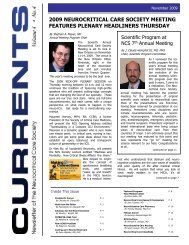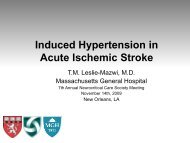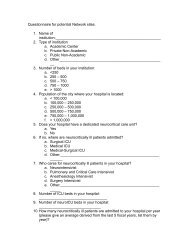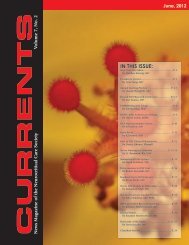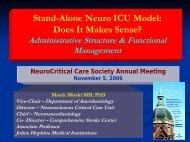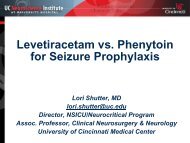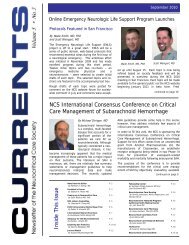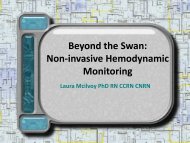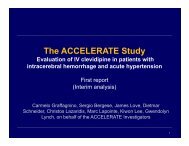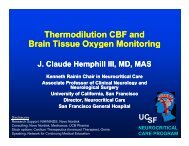The Future of Neurocritical Care in Germany W.F. Haupt
The Future of Neurocritical Care in Germany W.F. Haupt
The Future of Neurocritical Care in Germany W.F. Haupt
Create successful ePaper yourself
Turn your PDF publications into a flip-book with our unique Google optimized e-Paper software.
Comparison <strong>of</strong> hospital bedsHospital beds per 100,000 population<strong>Germany</strong> 640USA 390ICU beds per 100,000 population<strong>Germany</strong> 28France 38Italy 9Great Brita<strong>in</strong> 9USA 30
Structure <strong>of</strong> Health <strong>Care</strong> <strong>in</strong> <strong>Germany</strong>Ambulatory sector:Ambulatory care provided by physicians <strong>in</strong> private practiceIn general, no hospital privileges for private physiciansBill<strong>in</strong>g between organization <strong>of</strong> private physicians and health <strong>in</strong>suranceNo direct bill<strong>in</strong>g <strong>of</strong> patients <strong>in</strong> state health <strong>in</strong>surance systemHospital sector:Hospital care provided by salaried hospital physiciansIn general, no ambulatory treatment by hospital physiciansReferral <strong>of</strong> ambulatory patients to hospitals and vice versa
Age distribution <strong>Germany</strong> 2001
Structural problems <strong>of</strong> Germanmedical systemPoor f<strong>in</strong>ancial situation <strong>of</strong> state health system90% <strong>of</strong> population covered by state health <strong>in</strong>surance, 10% privately coveredPrivate <strong>in</strong>surance only for <strong>in</strong>comes >$ 3000 or self-employedHealth <strong>in</strong>surance based on wage <strong>in</strong>come only (50% employer, 50% employee)Current health <strong>in</strong>surance rate 14% <strong>of</strong> gross wage <strong>in</strong>comeFamily members <strong>of</strong> wage earners covered cost- freeUnfavorable demographics, low birth rateRapid <strong>in</strong>crease <strong>of</strong> cost <strong>of</strong> comprehensive medical treatment
Structural problems <strong>of</strong> German hospitalmedic<strong>in</strong>ePoor f<strong>in</strong>ancial situation <strong>of</strong> state health system: low <strong>in</strong>vestment level <strong>in</strong> hospitalsRestrictions <strong>of</strong> work<strong>in</strong>g time and shift work (EU court rul<strong>in</strong>g and other labor laws)Poor situation <strong>of</strong> federal research fund<strong>in</strong>gResearch fund<strong>in</strong>g by pharmaceutical <strong>in</strong>dustry ma<strong>in</strong>ly <strong>in</strong> English-speak<strong>in</strong>gcountriesPrivatizaton <strong>of</strong> hospitals <strong>in</strong>clud<strong>in</strong>g university medical centersMassive adm<strong>in</strong>istrative workload for physicians (> 50% <strong>of</strong> work<strong>in</strong>g time)DRG cod<strong>in</strong>g etc. perfomed by physiciansLow wages <strong>of</strong> residents and junior pr<strong>of</strong>essors (lowest <strong>in</strong> Europe)All these adverse conditions also affect Neurological Critical <strong>Care</strong>
Structure <strong>of</strong> Neuro ICUs <strong>in</strong><strong>Germany</strong>75 Neuro ICUs with between 4 and 15 beds eachUniversity hospitals: 23 Non-university hospitals: 52<strong>The</strong> majority <strong>of</strong> university neurological departments have Neuro ICUsSmaller (municipal) hospitals usally have comb<strong>in</strong>ed ICUsComb<strong>in</strong>ed ICUs usually are Internal Medic<strong>in</strong>e/Neurology orNeurosurgery/Neurology units
Current trends <strong>in</strong> German Intensive <strong>Care</strong>Structural:Concentration <strong>of</strong> ICUs under the leadership <strong>of</strong> anaesthesiologistsConsolidation <strong>of</strong> ICUs <strong>in</strong> a unified <strong>in</strong>tensive care systemFormation <strong>of</strong> units for "conservative" and "operative" <strong>in</strong>tensive careQualification:Abolishment <strong>of</strong> specialized <strong>in</strong>tensive care (<strong>in</strong>ternal med., surgery, neurology etc)Introduction <strong>of</strong> a unified specialist for <strong>in</strong>tensive care medic<strong>in</strong>e
<strong>Future</strong> trends <strong>in</strong> GermanCritical <strong>Care</strong> Medic<strong>in</strong>eMassive concentration <strong>of</strong> resourcesClos<strong>in</strong>g <strong>of</strong> approximately 30 % <strong>of</strong> mostly smaller hospitalsConcentration <strong>of</strong> ICU facilities <strong>in</strong>to a smaller number <strong>of</strong> unitsManagement <strong>of</strong> "surgical" ICUs by anaesthesiologists/<strong>in</strong>tensivistsManagement <strong>of</strong> "conservative" ICUs by <strong>in</strong>ternists and neurologists
P.G.Batoni: Hercules between virtue and love (1748)
To lump or to split?To lump:Organize all ICU beds <strong>in</strong> a s<strong>in</strong>gle <strong>in</strong>tensive care unitSynergy effects will improve cost situationThis will <strong>in</strong>variably be led by anaesthesiologists or <strong>in</strong>tensivistsTo split:Individual specialty ICUs will only be feasable <strong>in</strong> large centersSpecialty ICU will preserve <strong>in</strong>dependence <strong>of</strong> Neurology <strong>in</strong> patientcare, tra<strong>in</strong><strong>in</strong>g, and reseachCompromise: Surgical ICUs versus Conservative ICUs
Possible comb<strong>in</strong>ations <strong>of</strong>Intensive <strong>Care</strong> UnitsNeurology and Internal Medic<strong>in</strong>eNeurology and CardiologyNeurology and NeurosurgeryNeurology and SurgeryNeurology and Anaesthesiology
Two probable ma<strong>in</strong> pathways for thefuture <strong>of</strong> German <strong>Neurocritical</strong> <strong>Care</strong>Alternative 1Neurology and Internal medic<strong>in</strong>eConcept <strong>of</strong> "conservative" ICUProximity <strong>of</strong> stroke patients (60% <strong>of</strong> Neuro ICU patients) to <strong>in</strong>ternalmedic<strong>in</strong>eIntensive care is a core discipl<strong>in</strong>e <strong>of</strong> <strong>in</strong>ternal medic<strong>in</strong>e and neurology,therefore high <strong>in</strong>terest <strong>in</strong> preserv<strong>in</strong>g <strong>in</strong>dependence
Alternative 2Neurology and NeurosurgeryConcept <strong>of</strong> "bra<strong>in</strong>" <strong>in</strong>tensive careProximity <strong>of</strong> patients to neurosurgery for operative treatment(decl<strong>in</strong><strong>in</strong>g)Neurosurgeons usually not <strong>in</strong>terested <strong>in</strong> neurocritical care,therefore, non-operative care <strong>of</strong> bra<strong>in</strong> trauma patientstransferred to neurology
What might improve the outlook for<strong>Neurocritical</strong> <strong>Care</strong> <strong>in</strong> <strong>Germany</strong>?Established NICUs <strong>in</strong> most university hospitalsEstablished neurocritical care society (GSCCN) s<strong>in</strong>ce 1984 ( 500 members)Annual meet<strong>in</strong>gs with 600 to 800 attendees, 120-150 posters<strong>Neurocritical</strong> <strong>Care</strong> summer schools for residentsLarge proportion <strong>of</strong> Neurology residents tra<strong>in</strong>ed <strong>in</strong> <strong>Neurocritical</strong> <strong>Care</strong>Cont<strong>in</strong>u<strong>in</strong>g <strong>in</strong>terest <strong>in</strong> research <strong>in</strong> <strong>Neurocritical</strong> <strong>Care</strong>
Alexander the Great and the Gordic KnotJ.S. Barthelemy (1743-1811)



